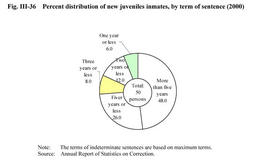As for juvenile inmates, in light of the characteristics of these inmates, juvenile inmates receive the treatment based on the 2 fundamental concepts. The first is"individualization of treatments" (forming a plan of individual treatments, designation of the individual person in charge, implementation of grading). The second is"diversification of nature and method of treatments" (individual interviews, individual guidance such as daily report guidance, guidance by type of treatment making use of each method of treatment, encouragement to take courses for vocational training). Juvenile inmates under 16 admitted to juvenile training schools are not obligated to undertake labor and undergo correctional education even if they were sentenced to imprisonment with labor.
In addition, subjects of vocational training include welding, automobile maintenance, electrical engineering, etc. Many have obtained publicly acknowledged qualifications and licenses or acquired vocational skills that aid self-sustenance and rehabilitation after their release.
For academic education, Matsumoto Juvenile Prison established a branch of a local public junior high school within its premises. Also, Matsumoto, Nara, and Morioka Juvenile Prisons have launched correspondence courses for senior high school education in cooperation with local prefectural senior high schools. In March 2001, 10 inmates completed senior high school education programs. It is also possible to take correspondence courses in social and school education (Source:Correction Bureau, Ministry of Justice).
Fig. III-36 Percent distribution of new juveniles inmates, by term of sentence (2000)
